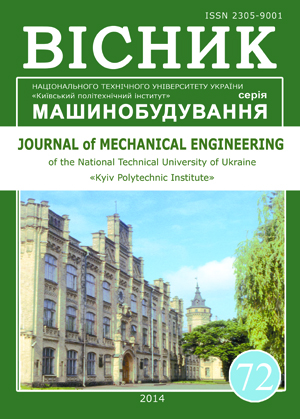BIOMECHANICS CHARACTERISTICS OF THE DIFFERENT WAYS OF FIXING FRACTURES IN KNEE JOINT
DOI:
https://doi.org/10.20535/2305-9001.2014.72.36827Keywords:
experimental biomechanics, surgery, traumatology, tibia, fraction, screws, cyclic loads, deformations, hardness, reliabilityAbstract
Purpose. Subject matter of the present paper is to investigate the characteristics of hardness and fixation of fractures with standard and self-tightening screws, fixing the oblique fracture of the proximal epiphyse of tibia in real regimes of external load including the cyclic ones.
Model / methodology / approach. During the experiment the specimen of limbs without pathology of the bone tissue had been used. Fixation of the bone fragments (osteosynthesis) had been performed by the means of standard and self-tightening screws. The tests had been conducted by the way of transmission of load through the distal joint of the epiphysial cartilage of the hip bone and through the injured distal condyle. Load regimes: single static influence and multiple cyclically changing loads, imitating the human weight.
Conclusion. During the transmission of the compressing force onto the fragment, the type of the fixing screw greatly influences the deformation of the osteosynthetic systems at all levels of load; permanent residual deformations (mutual shift of fragments) of the systems with self-tightening screws are much more lower if compared to the ones of the systems, employing the standard ones. Employment of the new type of screws significantly increases the fixation stability and generally increases the mechanical durability of the fixation of the oblique fracture of the proximal epiphyse of tibiaReferences
Bilinsky P.I. Korzh M.O. Experymentalne doslidgennya velychyny rukhluvosti ulamkiv preparatu kistky zalezhno vid sposobu fiksatsyi ta veluchuny navantazhennya. Vyiskova medutsyna Ukrayiny. 2003. 3, no. 1-2. P. 35-43.
Bilinsky P.I. Obgruntuvannya fiksuyuchych mozhluvostey fiksatoriv i prystroiv na fizuchniy modeli. Visnuk ortopedii, travmatologii ta protezuvannya. 2002. no 2. P. 47-49.
Nikitin P.V. Laksha A.M., Shydlowsky M.S. Zhorstkist riznyh typiv operatyvnoi fiksatsyi zaplesno-plesnevyh suglobiv pry naturalnomy modelyvanni homolateralnoho vyvyhu plesnovyh kistok (eksperymentalne doslidgennya). Litopys travmatologii ta ortopedii. 2005. No. 1-2. P. 16-20.
Tyazhelov A.A. Mikhailov S.R., Subbota I.A. Biomehanicheskoye issledovanie mehanicheskih svoystv zhestkoy i uprugo-stabilnoi modeli osteosinteza. Ortopedia, travmatologia i protezirovanie. 2003. No.2. P. 61-66.
Shydlowsky M.S., Laksha A.M., Burianov O.A. Doslidzhennya deformatsiynyh kharacterystyk system fiksatsyi scho vy-korystovuyutsya pry likuvanni poshkodgen kistok ta syglobiv. Vestnyk natsyonalnogo tekhnicheskogo universiteta Ukrainy. Kyiv. 2008. No.54. P. 51-62.

